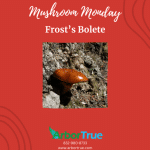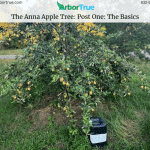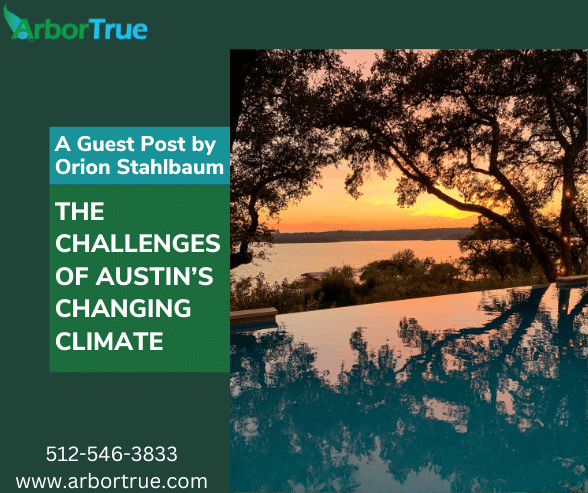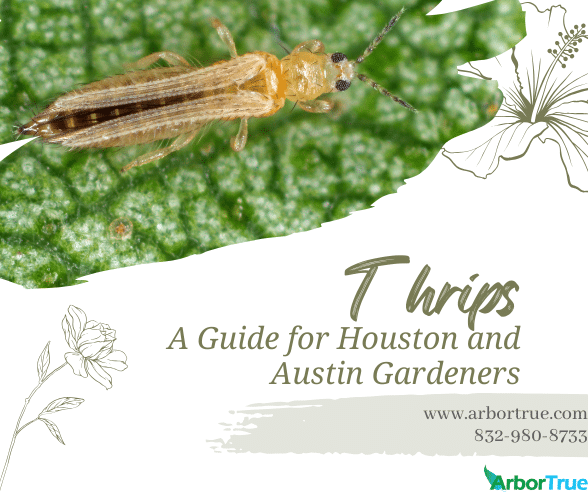
Mushroom Monday: Frost’s Bolete
June 17, 2024
The Anna Apple Tree: Post One: The Basics
June 21, 2024
The Challenges of Austin’s Changing Climate: A Guest Blog Post by Orion Stahlbaum
As many of you know, in addition to serving the greater Houston area, ArborTrue’s also in Austin and its surrounding communities. We’ve already done a lot there, helping with damage after storms and other projects, and are looking forward to being able to serve more people in the area.
One great person we have in Austin is our wonderful arborist Orion Stahlbaum. Orion is an ISA Certified Arborist® TX-3904A, is ISA Tree Risk Assessment Qualified, and is ISA Texas Oak Wilt Qualified. He is amazingly knowledgeable and enthusiastic about trees and he’s connected to and cares about his community.
Although he’s super busy in Austin, he took some time to write a guest post for our TrueTreeTalk blog about a very important issue: The Challenges of Austin’s Changing Climate. In it, he expands on the idea of what might be thought of as the impacts of a changing climate and looks at how they impact trees and ways we might adapt.
We want to thank Orion for sharing this great information and we hope you learn a lot from the post. If you’d like to schedule an arborist consultation with Orion, either for your residence or business, give us a call at 512-546-3833 or reach out to us online. We’ll help you set up an appointment.
The Challenges of Austin’s Changing Climate
By Orion Stahlbaum
The summer of 2011 was a doozy here in Austin, as we set a then-record of 27 straight days over 100 °F sandwiched by plenty of days in the upper 90’s. That year was Texas’ driest on record, with an average of only 14.8” of rain. I was in the best shape of my life and had the wildest farmer’s tan imaginable, thanks to my job at a local tree company. I spent my mornings delivering flyers door-to-door, walking about 10 miles a day in the scorching heat, and I spent my afternoons shadowing my boss on consultations or taking the fertilizer truck out for deep root fertilization jobs. I spent many of my evenings reading Alex Shigo’s revolutionary magnum opus on arboriculture, A New Tree Biology, fascinated by these incredible organisms as I studied to become a certified arborist.
Back then, the biggest concern for trees in Austin was pretty straight-forward: drought. Lack of water had dire consequences for many trees, although certain species seemed better able to handle the drought than others. At the time, this seemed like the challenging future we had in store for us with global warming – a hotter, drier climate that would continue to break records and transform Texas into one big desert.
Drought and extended periods of heat are still a major concern, as evidenced by the summer of 2023 where we set another new record for the city with 42 days over 105 °F. However, we’ve also seen that climate change is a multi-faceted problem, bringing with it an increase in the frequency and intensity of extreme weather events. For example, February of 2021 saw record-breaking temperatures of a different sort, as the temperature in Austin stayed below freezing for six consecutive days. Two years later in late January of ’23, we experienced a catastrophic ice storm.
These winter weather events had a devastating impact on Austin’s trees. The freeze of 2021, known as Winter Storm Uri, caused irreparable harm to several significant species in our urban forest, including many of our red oaks, post oaks, and Monterrey oaks. Uri was also responsible for greatly reducing the numbers of a few popular imported species, most notably the Japanese blueberry tree (popular as an evergreen privacy screen) and the loquat.
The ice storm of 2023 (Winter Storm Mara) was just as damaging if not more, but in a different way. The accumulation of ice on trees constituted an incredible load that many trees couldn’t bear. Collapsed trees abounded following the ice storm, and our beloved live oaks took the brunt of the damage. In addition to being viewed as a species with incredible structural integrity, live oaks are also well-adapted to Texas’ typical climate in a variety of ways. They are drought tolerant and seem almost invincible in a windstorm. They also grow slowly and utilize a thick, calloused leaf as part of a canopy that stays active year-round, taking advantage of the Texas sun in all months. Despite these qualities, while most broad-leaf trees had lost their leaves for the winter, the live oaks’ full canopy in January meant a much larger surface area for ice accumulation, leading to a city-wide damage of limbs and trees.
And so, it appears that the new reality for Austin in the era of climate change isn’t just hotter, drier summers but extreme winter events as well. This then raises the question, how does this impact trees here in Austin?
For this arborist, it has modified the way I recommend new trees to homeowners, businesses, and public entities. Where previously, I may have recommended drought-tolerant native tree species, today I recommend species that are climate-resilient, no matter their origin. I still love our native live oaks because they are drought and freeze tolerant, although the recommendations for pruning have changed as I note below. I have also begun championing the Mexican Sycamore (Platanus mexicana) as a fast-growing, drought and freeze-tolerant species; and the Chinese Pistache (Pistacia chinensis), which offers drought and freeze tolerance and the beauty of fall color.
For pruning, we must now account for the possibility of ice accumulation in addition to wind shear and other considerations. That means for live oaks we don’t want to let limbs get too long, especially with full foliage. If limbs get too long with full foliage, it can lead to excessive ice accumulation and limb failure.
One last thought on Austin in the age of climate change … how can we help our trees, and how can our trees help? We can help our trees by watering in the dry summer months, diversifying our tree species on a given property, and, where possible, planting or maintaining trees in groups – having a collection for trees works like a micro-forest, providing mutual insulation from temperatures and wind-breaking dispersion of gale-force gusts. Our trees can help us with climate issues by providing shade and temperature reduction in urban settings, as well as providing carbon sequestration which can reduce greenhouse gasses. In fact, two of Austin’s native species are ranked in the top 5 species for carbon sequestration: the live oak and the bald cypress.
We hope you liked this guest post from Orion and that you learned about this important subject. Be sure and check out the other posts on our TrueTreeTalk blog for other great content. Follow us on Facebook to keep up with these and other posts.
* * *
ArborTrue is a science-based tree-service company. We provide a range of services including tree trimming, tree pruning, tree removal, tree planting, arborist consultations, and more. Reach out to us online to schedule an appointment.




